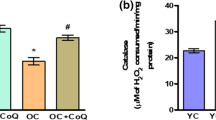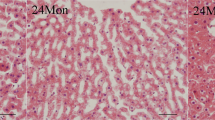Abstract
A shift from redox regulation to oxidative damage is known to contribute organ dysfunction and aging-related disorders. Exposure to reactive oxygen species throughout the life-span increases the incidence of several liver diseases. A redox basis of the loss of antioxidant capacity of aged livers has not been fully elucidated in both genders. In the current study, we investigated the gender-dependent relations between protein carbonyl (PCO), a commonly used marker of protein oxidation and other protein oxidation parameters such as advanced oxidation protein products (AOPP) and total thiol (T-SH). Our study also covered other oxidative stress markers, such as malondialdehyde (MDA), lipid hydroperoxides (LHP), and glutathione (GSH) in liver tissue of the male and female aged rats. PCO and AOPP levels in old male and female rats were significantly higher than those in the young control groups (P < 0.001 and P < 0.01, respectively for male rats; P < 0.001 for both parameters in female rats). On the other hand, T-SH levels were not found to be different between young and old rat groups. Plasma MDA levels of old male and female rats were significantly higher compared to those of the young control groups (P < 0.01 and P < 0.001, respectively). LHP levels were only found out to be significantly higher in old female rats when compared to those in young male rats. GSH levels in old male and female rats were significantly lower than in the corresponding young control groups (P < 0.01 for male rats; P < 0.05 for female rats). Our results demonstrated greater susceptibility to hepatic oxidative damage in females than in males. This appears to contradict the general assumption that females are less susceptible to oxidative injury than males are.









Similar content being viewed by others
References
Ali SS, Xiong C, Lucero J, Behrens MM, Dugan LL, Quick KL (2006) Gender differences in free radical homeostasis during aging: shorter-lived female C57BL6 mice have increased oxidative stress. Aging Cell 5:565–574
Balaban RS, Nemoto S, Finkel T (2005) Mitochondria, oxidants, and aging. Cell 4:483–495
Borrás C, Sastre J, Garcia-Sala D, Lloret A, Pallardó FV, Vıńa J (2003) Mitochondria from females exhibit higher antioxidant gene expression and lower oxidative damage than males. Free Radic Biol Med 34:546–552
Borrás C, Gambini J, Vina J (2007) Mitochondrial oxidant generation is involved in determining why females live longer than males. Front Biosci 12:1008–1013
Brink TC, Demetrius L, Lehrach H, Adjaye J (2009) Age-related transcriptional changes in gene expression in different organs of mice support the metabolic stability theory of aging. Biogerontology 10:549–564
Buege JA, Aust SD (1978) Microsomal lipid peroxidation. Methods Enzymol 52:302–310
De Grey ADNJ (2006) Free radicals in aging: causal complexity and its biomedical implications. Free Radic Res 40:1244–1249
Gasbarrini A, Addolorato G, Di Campli C, Simoncini M, Montemagno S, Castagneto M, Padalino C, Pola P, Gasbarrini G (2001) Gender affects reperfusion injury in rat liver. Dig Dis Sci 46:1305–1312
Harman D (1972) The biologic clock: the mitochondria? J Am Geriatr Soc 20:145–177
Humphries KM, Szweda PA, Szweda LI (2006) Aging: a shift from redox regulation to oxidative damage. Free Radic Res 40:1239–1243
Justo R, Boada J, Frontera M, Oliver J, Bermudez J, Gianotti M (2005) Gender dimorphism in rat liver mitochondrial oxidative metabolism and biogenesis. Am J Physiol Cell Physiol 289:C372–C378
Kayali R, Çakatay U, Tekeli F (2007a) Male rats exhibit higher oxidative protein damage than females of the same chronological age. Mech Ageing Dev 128:365–369
Kayali R, Çakatay U, Uzun H, Genç H (2007b) Gender difference as regards myocardial protein oxidation in aged rats: male rats have increased oxidative protein damage. Biogerontology 8:653–661
Lang CA, Mills BJ, Mastropaolo W, Liu MC (2000) Blood glutathione decreases in chronic diseases. J Lab Clin Med 135:402–405
Lang CA, Mills BJ, Lang HL, Liu MC, Usui WM, Richie J Jr, Mastropaolo W, Murrell SA (2002) High blood glutathione levels accompany excellent physical and mental health in women ages 60–103 years. J Lab Clin Med 140:413–417
Langley-Evans SC, Sculley DV (2005) Programming of hepatic antioxidant capacity and oxidative injury in the aging rat. Mech Ageing Dev 126:804–812
Pérez VI, Bokov A, Remmen HV, Mele J, Ran Q, Ikeno Y, Richardson A (2009) Is the oxidative stress theory of aging dead? Biochem Biophys Acta 1790:1005–1014
Reznick AZ, Packer L (1994) Oxidative damage to proteins: spectrophotometric method for carbonyl assay. Methods Enzymol 233:357–363
Rodriguez-Cuenca S, Pujol E, Justo R, Frontera M, Oliver J, Gianotti M, Roca P (2002) Sex-dependent thermogenesis, differences in mitochondrial morphology and function, and adrenergic response in brown adipose tissue. J Biol Chem 277:42958–42963
Sedlak J, Lindsay RH (1968) Estimation of total, protein bound, and non-protein sulfhydryl groups in tissue with Ellman’s reagent. Anal Biochem 25:192–205
Stadtman ER, Levine RL (2006) Chemical modification of proteins by reactive species. In: Dalle-Donne I, Scaloni A, Butterfield DA (eds.), Redox Proteomics. Wiley-Interscience, New Jersey. Ch. 1
Timchenko NA (2009) Aging and liver regeneration. Trends Endocrinol Metab 20:171–176
Uzun H, Kayali R, Çakatay U (2009) The chance of gender dependency of oxidation of brain proteins in aged rats. Arch Gerontol Geriatr 2009 Feb 19. [Epub ahead of print]
Witko V, Nguyen AT, Descamps-Latscha B (1992) Microtiter plate assay for phagocyte derived taurine-chloramines. J Clin Lab Anal 6:47–53
Wolff SP (1994) Ferrous ion oxidation in presence of ferric ion indicator xylenol orange for measurement of hydroperoxides. Methods Enzymol 233:182–189
Acknowledgments
This work was supported in part by funding from a grant from the Research Fund of The University of Istanbul (UDP-4/2010). The corresponding author is grateful to linguistic expert Mr. Burak Alkan for reading the manuscript and for improvements in the linguistic style.
Declaration of interest
The authors declare that there have been no competing interests with respect to the contents of this article.
Author information
Authors and Affiliations
Corresponding author
Rights and permissions
About this article
Cite this article
Aydın, S., Atukeren, P., Çakatay, U. et al. Gender-dependent oxidative variations in liver of aged rats. Biogerontology 11, 335–346 (2010). https://doi.org/10.1007/s10522-009-9257-8
Received:
Accepted:
Published:
Issue Date:
DOI: https://doi.org/10.1007/s10522-009-9257-8




